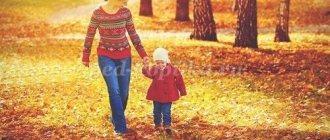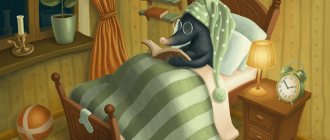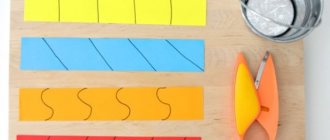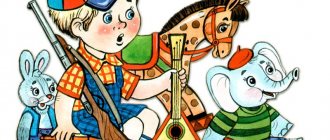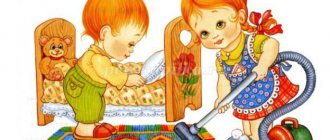Folder - travel "Autumn" : three folders - travel for kindergarten with pictures, poems and tasks for children about autumn.
In this article you will find three folders—movements on the theme “Autumn” for parents of children of different ages and useful ideas for using them:
- folder “Autumn” for early ages (from 2 to 3 years),
- folder “Autumn” for children of primary preschool age (for children 3-4 years old),
- “Autumn” folder for older preschool children (5-7 years old).
Each folder contains 10 sheets and you can choose those that will be most interesting to you and your children and arrange them in any order. Therefore, we did not specifically number the sheets.
All folders - translations on the theme “Autumn” from this article can be downloaded for free and printed. I have provided download links below in this article.
Folders - moving “Autumn” for preschoolers: contents of folders
Each of the three folders contains the following pages:
- What does a child of this age know about autumn? What to tell him about.
- Pictures about autumn to look at with your child.
- Educational autumn games and experiments.
- Poems about autumn to read to children and memorize.
Each page has a landscape sheet format - A4 (vertical).
The material in each folder is designed taking into account the age of the children and all methodological requirements for familiarizing preschoolers with the world around them.
All sheets of folders are colorful and bright, realistic and are designed so that the pictures can be viewed with a child while discussing autumn phenomena in nature.
We tried very hard to create a special mood in each folder and look at autumn through the eyes of a child! And also bring joyful mood and smiles to all of you - our readers! Therefore, the folders turned out to be very bright and kind, very sunny and bringing you our warmth!
The authors of the “Autumn” folders are: I, Asya Valasina, Candidate of Pedagogical Sciences in the field of preschool pedagogy, practical teacher, author of this site “Native Path”. And designer Anna Novoyarchikova.
All materials in the book folders can be transferred to friends, colleagues, acquaintances, downloaded and printed, and used in kindergartens, centers, and families. We, the creators of these folders, will be glad if our work is in demand and needed by people, and as many people as possible use it! Therefore, we make these folders free for distribution and you can get them without any payments or subscriptions.
Why do teachers need “Autumn” folders?
- Folders can be used as visual material for parents in kindergartens and children's centers (for example, a mobile folder can be located in the hallway of a kindergarten or in the locker room of a kindergarten group). This folder introduces parents to what educational games they can play with their child in the fall, what poems about autumn are intended for children of this age, and what to tell the child about in the fall.
- Folders can also be used as handouts for parents of preschool children on the topic “Autumn” at various family workshops and play libraries,
- The mobile folder can be printed as an A4 book, inserted into files (for this you need to purchase special folders with files) and get the book “Autumn” for the kindergarten group. This book can be passed from family to family and viewed in a group with children. It will serve you for a very long time!
Autumn Festival in kindergarten: preparatory work
As part of the Osenin, a number of events can be planned in a preschool institution, which are announced long before the Autumn Ball in the kindergarten itself.
Joint projects with parents in the fall
Autumn events are an additional opportunity to organize interesting and useful leisure time for parents and children.
Almost every preschool institution hosts an exhibition of autumn crafts that children bring from home. Crafts can be made using natural materials: leaves, acorns, chestnuts, linden earrings and other “gifts of autumn”, or using ordinary materials (paper, paints, felt-tip pens), but on the theme of the golden season. Children, as a rule, are very proud of their little masterpieces and, for example, they bring their crafts to our kindergarten very carefully and so that everyone else can see it.
Exhibition of family works at the Child Development Center - kindergarten No. 2336, Moscow
Another direction is organizing a photo gallery made up of photographs of children. Parents take pictures of their children against the backdrop of autumn landscapes during weekend walks.
In kindergarten, you can also hold a culinary competition , preparing dishes for which will most likely be a task for mothers. These can be dishes with an autumn theme or decorated with vegetables: eggplants, carrots, pumpkins and other “gifts from the garden.”
Works of parents of MBDOU "Combined Kindergarten No. 28" in Chistopol
Thematic activities in kindergarten
Preparations for the Autumn Festival essentially begin in the summer. Children actively work in the mini-garden, growing vegetables and fruits that ripen just in time for autumn - and from them they prepare delicious dishes at master classes. Children from the senior group act as cooks, and children of junior preschool age act as spectators and judges.
Culinary master class at Neskuchny kindergarten No. 183, Moscow
The Autumn Festival in kindergarten is preceded by a trip to the autumn park, where outdoor games are held. Competitions and quizzes are organized among children: who can collect the most leaves for the herbarium? Who can guess faster which tree the leaf came from?
Child Development Center No. 2336 on a walk, Moscow
In groups, children together with teachers make crafts: for example, applications from berries, molding mushrooms, and so on.
Crafts from group No. 5 of the Child Development Center - kindergarten No. 2336, Moscow
How parents of preschool children can use the “Autumn” folder
Option 1: Print the folder. And use it as a book or as a cheat sheet throughout the day.
Examples of using a move about autumn: We print the folder onto separate A4 sheets. Then it is very convenient to use these sheets with children, choosing the desired sheet for today. You can always take one piece of paper with a poem on a walk with your baby. And during a walk, take it out, look at the picture with your child, and read a poem to the child from this piece of paper. A sheet of paper from a folder looks very aesthetically pleasing and is convenient to look at with your baby; it is light and does not take up much space like a book or album. Then you and your child can look at the nature around you and find signs of autumn - the same as in the picture or in the poem from the folder.
A valuable idea from the experience of mothers: Many parents hang sheets of folders on the refrigerator (changing them) or on a home magnetic board and look at them with their children. These sheets serve as a cheat sheet - a reminder of a poem or a fall game planned for today with your child.
Option 2. Mobile option for using a folder about autumn without printing the folder on a printer. This option appeared in my experience of working with parents many years ago, when mobile phones with camera functions first appeared. Very convenient, fast way. You just need to save the pictures from the “Autumn” folder to your mobile phone. During a walk, you can always open the desired photo and read a poem to your child, look at the picture and find a similar landscape in the park around your baby, or remember an idea for a game and immediately play it with your child.
Working with a group of children, I often made such development folders and noted that parents did not just read them (and this is often what happens: they read them and happily... forgot). On the contrary, almost everyone takes pictures of my materials on their mobile phones and then returns to them at home and saves them for themselves. This is very convenient - you will always have a folder about autumn with you and does not take up space. Therefore, I decided to share “Native Path” with all readers.
We made three folders - movements about autumn according to the ages of children: early age (up to 3 years), junior preschool age (3-4 years), senior preschool age (5-7 years).
Now I will show examples of pages from folders - movements about autumn and give links to download these pictures in full format for printing.
Consultation for parents “How to protect yourself from colds”
Consultation for parents
"How to protect yourself from colds"
Colds are the most common problem that young mothers face literally from the first months of a baby’s life, and some begin to perceive it as a necessary evil.
There are several simple rules that can significantly reduce the likelihood of colds. Let's try to summarize them.
1. Fresh air.
A lot has been said and written about its necessity for a baby, but often the implementation of this recommendation comes down to walks at a comfortable temperature. Walking with your baby is possible from -15 to +30 degrees, i.e. almost any time of the year.
Rain, snow and moderate wind are also not obstacles to taking your child outside for at least half an hour. But besides walking, you need to remember another important procedure, which is often neglected - ventilation. When the child is outside, open ALL the windows in the house, and even better, the windows (if possible). Don’t be afraid that the house will be cold when you return - the air will quickly heat up, but through ventilation will help get rid of bacteria and viruses that actively multiply in a warm, stuffy enclosed room.
Put your child to bed in a cool, well-ventilated (for at least half an hour) room. This will ensure good sleep and serve as an additional means of prevention. If the weather permits, it is better to sleep with an open window in the summer, and with an open window in cold weather. A temperature of 15 degrees is not cold, but optimal for sleep; it is better to put warm, comfortable clothes on the child and cover them with a blanket. However, drafts should be avoided when the child is indoors.
2. Baby's clothes.
The advice not to bundle up children is as old as the hills, but often in the fall parents rush to dress their child in winter overalls, and even wrap them in a blanket. At home, children are often bundled up in several layers of clothing. By doing this, we disrupt the natural thermoregulation of the baby’s body and, as a result, its resistance to infections. The child should not be hot, he should not sweat. Cool arms, legs and even a nose are not an indication that he is cold. If you want to check if your baby is warm, touch his body behind the collar in the back area. If it's warm, then everything is fine.
In the summer, take every opportunity to let your child walk around without shoes. Of course, asphalt is not suitable for this, but grass, sand, even soft pebbles - all this helps not only to harden the child, but also to develop his motor skills.
3. Water procedures.
You should not teach your child to bathe in hot water. Many children feel a temperature of 37-38 degrees as uncomfortable; they feel hot. Gradually reduce the intensity of heating the water in the bathroom to 30 degrees and slightly lower. Cold and contrasting douches are also usually liked by children, but they should be introduced gradually. After one and a half years, do not be afraid to swim with children in open waters, if they are clean enough.
4. Natural bacterial background.
Do not try to create a sterile environment around the child by treating all objects around with disinfectants. Simple hygiene rules are enough. Bacteria surrounding the baby in natural conditions also contribute to the gradual development of immunity. But it’s also not worth taking risks by visiting public places during epidemics of viral infections or allowing a child to come into close contact with a sick person. It is better to refrain from even a scheduled visit to the pediatrician during widespread flu or acute respiratory infections.
5. Nutrition.
This is also an important factor. Food should be varied. It is worth considering that protein, for example, helps strengthen the immune system; iron and zinc contained in meat and fish have antiviral activity, and are also antioxidants, like vitamins A, C, E, found in vegetables and fruits. Calcium contained in dairy products reduces vascular permeability and has an anti-inflammatory effect; lactic acid bacteria form healthy intestinal microflora. Vitamin and mineral complexes, correctly selected by a pediatrician, will also help support the child’s immunity, especially in the winter and spring.
The integrated use of all these simple recommendations can reduce the risk of colds by 2-3 times.
Health to you and your children!
Detailed description of folders - movements about autumn by age of children
Please note: In this article I am giving compressed images from a folder as an example.
You can download full pictures from all folders in excellent quality in the file using the links above.
Each folder is unique and the contents of each folder are not duplicated in other folders.
Folder - moving "Autumn": for parents of young children (2-3 years old)
The moving folder about autumn for young children includes the following sheets:
- Title,
— What does a 2-3 year old baby know about autumn? And pictures of autumn natural phenomena to look at with your child.
— Learning to look at pictures: seasons
— Learning to speak and playing with the autumn rain: speech exercises on a home walk.
— Autumn educational games and tasks for the little ones: “Colorful leaves”, “Big - small”, “Dance with leaves”, “Where is the leaf?”, “What can you hear?”, “Learning to speak”, “Magic box”.
— We introduce the baby to the outside world during a walk in the yard
— Poems about autumn for the little ones: “Why do trees shed their leaves in autumn?” V. Orlov, “My little guest” V. Orlov, “Autumn Leaves” by I. Tokmakov, “Autumn Song” by A. Pleshcheev, “Autumn” by V. Avdienko, “Hedgehog” by I. Mogilevskaya, “Autumn” by Y. Korinets.
— Sheets “And this is me in the fall” for pasting home autumn photographs into an album or folder. You can paste autumn photographs of children, kindergarten groups, and photographs of children’s drawings about autumn into frames. The result will be sheets of galleries in which the baby will see himself! It is very important for a young child to look at photos of his mom, dad, all his relatives and himself in the fall: what the weather is like, who is doing what, who is wearing what.
The download link for this folder is given above in this article.
Folder - moving "Autumn": for parents of children 3-4 years old
Below in the folder description are examples of pictures in a compressed format. You can download the same pictures in full size and good resolution for free above in this article in the section “Download moving folders “Autumn”
The moving folder about autumn for children of primary preschool age includes the following sheets:
- Title,
— What does a 3-4 year old child know about autumn?
— Poems about autumn for children 3-4 years old: I. Bunin “Autumn”, K. Balmont “Autumn”, A. Koltsov “The winds are blowing”, M. Khodyakova “If the leaves on the trees turned yellow”, E. Trutneva “It suddenly became twice as bright”, A. Teslenko “Autumn”, A. Pleshcheev “Boring picture”, L. Razvodova “The rain of mischievous leaves swirled above me.”
— Educational games on an autumn walk with a 3-4 year old child: “Which branch are the children from?”, “Casts from nature”, “Drawing a herbarium from leaf prints”, “Find the same one”, “Developing the eye. Swing for a leaf", "Introducing a child to trees", "Leaf prints with colored pencils", "Riddle game: autumn trees"
— Autumn mathematics on a walk with a child: “How are they similar?”, “What is more?”, “Continue the pattern.”
— For little reasons: why is the hare white in winter and gray in summer? Experiment for children.
— Signs of autumn: pictures with the task for the child “Find the signs of autumn.” While discussing the top picture with your child, ask him why this is not summer? After all, it also rains in summer. Pay attention to the girl's warm clothes. If she dressed warmly, that means...? (it’s cold outside, but warm in summer). In the bottom picture, find signs of autumn (the harvest is ripe, the leaves are falling).
Consultations for parents on the topic: “Autumn”consultation (junior group) on the topic
Autumn
Consultations for educators on the topic: “Seasons.”
SEASONS. SEPTEMBER At first imperceptibly, furtively, and then declaring itself louder and louder, autumn crept up. The crowns of the aspens have turned red, the linden and birch trees have turned golden, and the lingering rains are falling more and more often. Migratory birds are gathering in flocks - it's time, it's time to go to warmer climes! Thrifty four-legged animals are in a hurry to gather supplies - winter is just around the corner. The trees are shedding their last leaves. The sky is increasingly covered with low, shaggy clouds, from which snow is about to fall, cooling the ground air.
And here it is September! Slowing down its rise, the sun shines with a cold radiance, and its ray in the mirror trembles like unsteady waters, like unfaithful gold.
September has arrived. The days shortened, drawing closer to the nights, the fogs thickened, shrouding the lowlands in the evenings, and cobwebs sparkled under the slanting rays of the sun, drawn by the breeze. A fine summer afternoon is ardent, hot, captivating. They thought that the drier and warmer September remained, the later winter would come. The Old Russian name for September “ruen” was associated with the yellow color of autumn, “howler” with rain and bad weather, “gloom” with the fading of sunlight and early twilight. Indian summer is the best time of autumn. According to old reports, it lasts only a week, from September 14 to 21. Who doesn’t like warmth, even if it’s farewell? How wonderful these days are! The sun is hot from above, illuminating the azure vault of the sky, the quiet air is transparent, dry, it seems that summer has accidentally returned. If the first day of Indian summer is clear, then autumn will be warm. Indian summer is stormy - autumn is dry. September 28 - “flying goose”. Dark, cold evenings and pre-dawn freshness cool the air and the earth. The last days of pensive September are announced by the calls of departing geese and cranes.
In the original autumn there is a short but wonderful time - The whole day is as if it were crystal, And the evenings are radiant... The air is empty, the birds are no longer heard, But the first winter storms are still far away, And clear and warm azure is pouring onto the resting field...
Apple trees produce ripe fruits. Tansy is still full of charm: the yellow inflorescences look like the heads of petalless daisies. Field work is almost complete. Now there is time to talk and reflect.
*A lot of acorns on an oak tree in September - for a fierce winter. A lot of shade in Indian summer - for a clear autumn and a cold winter. *September sees off the red summer, welcomes the golden autumn. *The drier and warmer September stays, the later winter will come. *Although the leaves have turned yellow, they are falling slightly - frosts will not begin soon .*Rare clouds—it will be clear and cold.*Cirrus clouds are harbingers of close flights of bird flocks.*We started collecting rose hips—autumn has arrived.*Thick warm fogs warn of the beginning of mushroom season.*Thunder in September foreshadows a warm autumn.*September without fruits does not happen. *September is the evening of the year.
ADVICE FOR PARENTS In autumn, children get acquainted with autumn natural phenomena. Children watch the leaves of trees and bushes color. On sunny, warm days after the first frost, the leaves turn crimson, orange, yellow, and golden colors, which gives the leaves an elegant and beautiful appearance. Tip: tell the children why the leaves turn yellow. After the first frost, when the wind blows, the leaves are easily separated from the branch. Massive leaf fall begins and the ground is covered with a layer of dry, rustling leaves. Tip: tell the children why the leaves fall and become dry. What to read to children? *F. Tyutchev “There is in the primordial autumn...” *V. Stepanov “Sparrow” *K. Balmont “Autumn” *A. Maikov “Autumn Leaves” *A. Barto “A Joke about Shurochka” *O. Ivanenko “Good night” *I. Sokolov–Mikitov “Forest in Autumn” *V. Bianki “Forest Houses” *G-H. Andersen "Chamomile", "Little Ida's Flowers"
SEASONS OF OCTOBER Through the golden valley You are leaving, silent and wild. A crane's receding cry is drawn in the sky. Freezes, it seems at the zenith. A sad voice, a long sound. The triumphant spider endlessly pulls the threads. For elegant clothes, Autumn gave the sun Flighted hopes of Inspirational warmth.
The beginning of October, as a rule, begins with complete variegation of trees and massive leaf fall. A sharp change in weather is accompanied by increased leaf fall. The death of herbaceous vegetation is observed everywhere. The days are still surprisingly fine and dry. At noon, the sun peeks through the cloud banks, spreading a brief farewell warmth. The bronze blizzard of leaf fall rustles. The golden gusts of autumn transform the forest so that the cold does not take it by surprise. Autumn. With sadness and anxiety he rustles a fallen leaf. Among the brothers, October is the most elegant month, the most picturesque, especially at the beginning. If in October a leaf from a birch or oak falls uncleanly, expect a harsh winter. And here is the famous Intercession, October 14th. “It’s autumn before Pokrov, and after lunch it’s winter-winter.” If snow falls on Pokrov, then the winter will be snowy. People call October the muddy month, the winter season.
Cold winds tirelessly insist that stormy days are approaching, dying early. After all, the incessant rains will soon begin. The days rolled by one shorter. October still delights with dry, fine days and bright green grass. In the mornings, the puddles are glazed with ice, and heavy dew does not leave the cold meadow for a long time. The waters of ponds and rivers are purified. In the meadows, popovka daisies and squat white chickweeds have not yet faded, and near the rivers, gravilat and creeping tenacious have bloomed a second time. After the golden autumn that embraces the first half of October, pre-winter slush, rain and snow await. Winter is not far away already.
October has already arrived - the grove is already shaking off the last leaves from its naked branches; The autumn chill has breathed in - the road is freezing. The stream is still murmuring behind the mill, But the pond has already frozen; my neighbor hurries to the departing fields with his eagerness, and the winter suffers from mad fun, and the barking of dogs awakens the sleeping oak groves.
After the golden autumn that embraces the first half of October, pre-winter slush, rain and snow await. Winter is not far away already.
Popular wisdom says
*If there is a lot of rowan in the forest, autumn is rainy, if there is little, it is dry. *In October there is thunder - winter is snowless, short and mild. *October is the month of close powder. *From what date in October the weather will be good, from that date spring will open in April. *Autumn frost - to dry, sunny weather. *Until the cherry leaves fall cleanly, no matter how much snow falls, the thaw will drive it away. *In October, say goodbye to the sun, get closer to the stove. The face of nature is becoming increasingly gloomy: The vegetable gardens have turned black, the forests are becoming bare, the bird voices are falling silent, the bear has fallen into hibernation. What month did he come to us? (October)
Our Queen, Autumn, We will ask you together: Tell your children your secret, Who is your second servant? (October)
ADVICE FOR PARENTS
The gifts of nature are multifaceted, numerous and beautiful. Children take great pleasure in collecting fallen leaves, so generously painted in bright colors in autumn; cones and acorns thrown from trees by wind currents or by restless inhabitants of forests and parks. Children use bright natural materials not only in creative activities, but also in play. By going through and examining each pebble, leaf, cone, children accumulate impressions and knowledge about their properties and qualities: smooth - rough, voluminous - flat, large - small, strong - fragile, etc. In addition, children develop fine motor skills fingers, which contributes to the best positioning of the hand for writing, the development of correct sound pronunciation, and coherent speech. Invite your children to play with natural materials at home. Games: * sort through the seeds of maple and ash * sort out the natural material by size and quality * trace the leaves along the outline and color them * draw an autumn pattern with an imprint of the leaves * complete the picture from plasticine with small details * fold from natural material portrait of your favorite fairy-tale hero
Advice: parents need to allocate a place at home where they can conveniently and easily place natural material for working with it and playing activities.
SEASONS. NOVEMBER November is the coldest month and is characterized as pre-winter. A temporary but fairly stable cover appears. The landscape takes on autumn-winter features. Reservoirs are covered with thin young ice. The leaf fall of the trees ends and the time of active plant life begins to fade.
It's a sad time! the charm of my eyes! Your farewell beauty is pleasant to me - I love the lush decay of nature, the forests dressed in crimson and gold, in their canopies the sound of the wind and fresh breath, and the skies covered with wavy darkness, and the rare ray of sun, and the first frosts, and the distant threats of gray winter. It's getting cold. The prickly morning performance seems to warn that severe frosts on the ground and in the air have entered into force. The golden grove has faded, all the beauty below is decaying. The appearance of November is colorful. Black path, snow. The purpose of November is to connect deep autumn with persistent winter. The November period is called pre-winter, when wildlife is finally preparing for the harsh tests of the long cold season. November 12 - Zinovia - the titmouse holiday. The feathered guests of winter flock: bullfinches, goldfinches, waxwings...November 14 - welcoming winter, autumn funeral.
An unprepossessing November day. The sun will peek out for a short time and disappear: the sky is covered in a leaden, cloudy pillowcase. The days are decreasing, and the nights are getting longer and longer.
The Christmas tree has become more noticeable in the forest, It is tidied up before dark and is empty. And bare as a broom, Clogged with dirt by the dirt road, Blown with ash frost, The vine bush is trembling and whistling.
When the sun glimpses fleetingly, the September warmth is remembered, but the sparkling ray is obscured by clouds and everything around fades and fades... Damp, soft, grayish-pale snow stained the ground, adorned the deserted branches of the trees. Winter is getting stronger and stronger, sending cold and snow. But cold weather gives way to warm weather, snow turns to rain.
*In November, winter fights with autumn. *In November, it can rain in the morning, and by the evening the snow can lie in drifts. *Mosquitoes in November - there will be a mild winter. *November is an off-road: either snow, then mud, then mud, then snow - neither the wheel nor the runner can move. *November is the grandson of September, the son of October, the dear father of winter.
And yet winter takes precedence over autumn. The luminous ray of the sun noticeably weakens, and winter comes from the northeast, increasingly showering the tired nature with snow.
Summer has thrown off the green caftan, The larks have whistled to their hearts' content, Autumn, dressed in a yellow fur coat, Walked through the forests with a broom, So that a zealous housewife could enter into the snowy forest towers A dapper woman in a white flyaway - Russian ruddy winter!
ADVICE FOR PARENTS Small experiments and entertainment that can easily be done at home or away will help you pass the boring, rainy days of November. They will not require serious preparation, but will bring a lot of joy. “Guessing Game” The children have various pairs of objects in front of them. Children look at them and determine how they are similar and how they differ. (Similar in size, different in weight.) Take the objects in their hands and check the difference in weight. Next, children are asked to determine, with their eyes closed, by the sound of an object falling on the floor whether it is light or heavy. (A heavy object has a louder impact sound.) They also determine whether an object is light or heavy by the sound of an object falling into the water. (The splash is stronger from a heavy object.) Then they throw the objects into a basin of sand and determine whether the object was carried by the depression left after the fall in the sand. (A heavy object makes a larger depression in the sand.)
Reading to children
*N. Abramov “Autumn Tale” *A. Lukyanova “The Tale of the Beginning of Winter” *L Sokolova “The Tale of How the Fox Learned about Autumn” *I. Sokolov–Mikitov “Stories about Animals” *A. Pleshcheev “Autumn Song” *V. Berestov “Lessons from leaf fall” *A. Pushkin “Autumn” *I. Bunin “Falling Leaves”
